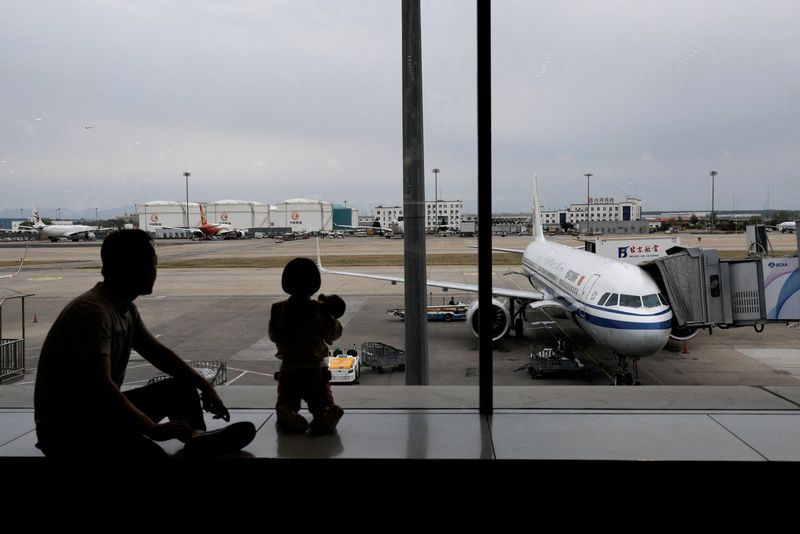Sophie Yu, Casey Hall, Lisa Barrington
BEIJING/SHANGHAI (Reuters) – A recovery in overseas travel by Chinese people since the coronavirus pandemic is faltering as soaring travel costs and difficulties obtaining visas lead to a preference for domestic and shorter-haul destinations.
The slow recovery of outbound travel from China, the world's top spender on international tourism and air travel, to pre-coronavirus levels is hitting travel companies, hotels and retailers around the world.
Eighteen months have passed since China lifted its strict zero-COVID policy and reopened its borders, but the recovery of international travel has lagged behind market expectations, and the way Chinese people travel is changing, with domestic travel surging.
Weighed down by a prolonged real estate crisis, high unemployment and a bleak outlook for the world's second-largest economy, Chinese consumers have become more frugal since the pandemic began, sparking price wars on everything from travel to cars, coffee and clothes.
Chinese people took 87 million international trips last year, 40% down from pre-COVID 2019, and industry observers say the pace has slowed since the Chinese New Year in February. Data from the United Nations Tourism Office shows that spending by Chinese tourists fell 24% last year compared to 2019, while spending by American tourists increased 14%. China's lagging is bad news for countries such as France, Australia and the United States that were top destinations for Chinese tourists before the pandemic.
Liu Simin, deputy director of the tourism department at the China Future Study Association, predicts it may not be another five years before China's outbound travel recovers to pre-pandemic levels.
“The recovery has been much slower than expected,” Liu said, “due to the double blow of currency devaluation and inflation in the U.S. and Europe.”
The yuan has fallen more than 2 percent against the dollar since the beginning of this year, raising costs in yuan terms for Chinese people traveling abroad.
Consultancy Oliver Wyman last month brought forward its forecast for a recovery in Chinese international travel to the second half of 2025, six months later than it predicted last year.
“I would argue that consumers are even more cost-conscious than they were last year, and you'll see that impacting travel trends,” said Imke Wouters, a Hong Kong-based partner at Oliver Wyman.
To be sure, international travel is recovering, with Chinese visitors once again becoming the world's largest spenders on international tourism last year after lagging behind the United States in 2022, according to United Nations tourism data.
This summer, 8% of flights at Chinese airports were international, up from just 1% in 2022, according to aviation data provider OAG.
Switch to domestic travel
But the recovery was overshadowed by domestic travel during the five-day May Day holiday, which reached a record 295 million people, more than 20 percent higher than in 2019, according to official data.
Domestic airline seat numbers increased 16% in May compared to the same month in 2019, but international flights were down 30%, according to data from Cirium.
Oliver Wyman's Wouters said 40% of people who would have travelled abroad for the first time in 2023 since borders reopened have decided not to travel abroad this year, mainly due to the inconvenience and long visa processing times in many European destinations.
Beijing resident Wang Shu, 38, canceled a trip to France and holidayed in China after she was unable to get a visa despite trying to book one several months ago.
“I tried to schedule an interview in late March because I was planning to go to the French Open tennis tournament in late May, but the earliest date I could get an appointment was June 19,” Wang said.
Instead, Wang vacationed in Changsha, the capital of Hunan province, known for its spicy cuisine.
“The food was amazing, I saw a concert and spent a tenth of what I would have spent in France,” he said.
Australian Tourism and Transport Forum chief executive Margie Osmond said China, which was Australia's largest supplier of tourists before COVID-19, was now the fourth largest, with visitor numbers in March down 53 per cent compared with March 2019.
Chinese travellers to France, the world's most visited country, are at just 28.5% of 2019 levels, according to airport operator ADP.
Capacity on U.S.-China routes remains down more than 80% from 2019 levels due to rising political tensions between the two countries, and the U.S. National Travel and Tourism Administration expects Chinese tourism to the U.S. to not fully recover until 2026.
In contrast, countries with visa-exemption policies have seen a large increase in Chinese tourists.
These include Singapore, Malaysia, Thailand, the United Arab Emirates, Qatar and Saudi Arabia, which are also increasing their air transport capacity.
Switzerland, which is becoming increasingly popular among high-end Trip.com travelers, boasts a seven-day visa process, said Jane Sun, CEO of Trip.com Group.

The number of Chinese tourists visiting Japan has also increased sharply this year, partly due to the weak yen.
“Not only is the market re-growing, it's also reshaping the market,” Gary Bowerman, director of tourism information company Check-in Asia, said during an OAG webinar last month.



